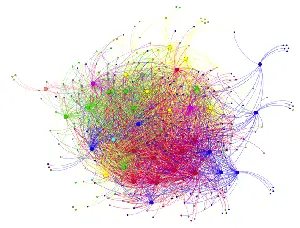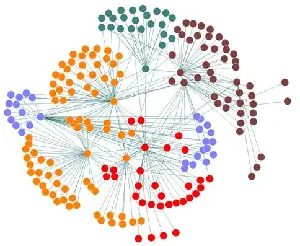About social network analysis
Published:
 Social network analysis is a field of study that focuses on the relationships and connections among individuals or organizations. It involves the use of methods and techniques from fields such as sociology, computer science, and mathematics to understand how these relationships and connections impact behavior, communication, and decision-making. By analyzing patterns of relationships within a network, social network analysts can gain insights into the structure and function of the network as a whole. This type of analysis is useful for a wide range of applications, including studying the spread of disease, predicting the success of marketing campaigns, and understanding the dynamics of social groups.
Social network analysis is a field of study that focuses on the relationships and connections among individuals or organizations. It involves the use of methods and techniques from fields such as sociology, computer science, and mathematics to understand how these relationships and connections impact behavior, communication, and decision-making. By analyzing patterns of relationships within a network, social network analysts can gain insights into the structure and function of the network as a whole. This type of analysis is useful for a wide range of applications, including studying the spread of disease, predicting the success of marketing campaigns, and understanding the dynamics of social groups.
There are several main methods used in social network analysis, including visual representation, centrality measures, and network models. Visual representation involves the use of graph theory to create a visual representation of the relationships in a network, typically using tools such as node-link diagrams or matrices. Centrality measures are used to identify the most important or influential nodes in a network, based on their connectivity or their centrality within the network. Network models are used to represent and analyze the structure of a network, and can be either statistical or computational in nature. These models can be used to test hypotheses about the relationships within a network, make predictions about network behavior, or simulate the spread of information or other phenomena through the network.
Social network analysis is often used in research to study the patterns and processes within social systems. It can be applied to a wide range of research questions, such as how information spreads through a network, how power is distributed within an organization, or how social ties influence behavior. Researchers may use social network analysis to study social networks within specific populations, such as students in a classroom or employees in a company, or to analyze larger networks such as the structure of social media platforms or the relationships among scientific researchers. By examining the structure and properties of these networks, researchers can gain insights into the dynamics of social systems and how they function.
 There are several benefits to using social network analysis in research and other applications. One benefit is the ability to visualize and understand the relationships within a network. By creating a visual representation of the network, it is easier to identify patterns and understand the overall structure of the network. Additionally, social network analysis allows researchers to quantify the relationships within a network, which can be useful for identifying patterns and making predictions. For example, centrality measures can be used to identify key players or influential nodes within a network, and network models can be used to predict how information or other phenomena will spread through the network. Another benefit of social network analysis is the ability to study large and complex networks, such as those found on social media platforms, which may not be possible using other methods.
There are several benefits to using social network analysis in research and other applications. One benefit is the ability to visualize and understand the relationships within a network. By creating a visual representation of the network, it is easier to identify patterns and understand the overall structure of the network. Additionally, social network analysis allows researchers to quantify the relationships within a network, which can be useful for identifying patterns and making predictions. For example, centrality measures can be used to identify key players or influential nodes within a network, and network models can be used to predict how information or other phenomena will spread through the network. Another benefit of social network analysis is the ability to study large and complex networks, such as those found on social media platforms, which may not be possible using other methods.
Social network analysis can be applied in a variety of real-world situations to understand and analyze social systems. Some examples include:
Studying the spread of disease: Social network analysis can be used to understand how diseases spread through a population and identify key individuals or groups who may be particularly effective at transmitting the disease.
Predicting the success of marketing campaigns: By analyzing the relationships among customers, businesses can use social network analysis to identify influential individuals and target their marketing efforts to improve the chances of success.
Understanding the dynamics of social groups: Social network analysis can be used to study the relationships within social groups and identify patterns of communication, influence, and power.
Analyzing the structure of organizations: Social network analysis can be used to understand the relationships and communication patterns within organizations and identify opportunities for improvement.
Studying online communities: Social network analysis can be used to understand the structure and dynamics of online communities, such as social media platforms or forums.
 There are several challenges and limitations to using social network analysis in research and other applications. One challenge is the difficulty of collecting accurate and comprehensive data on the relationships within a network. It can be difficult to obtain complete information on all of the relationships within a network, and the accuracy of the data may be compromised if individuals are reluctant to disclose information about their relationships. Another challenge is the complexity of analyzing large networks, which can require specialized software and expertise to manage and analyze the data. Additionally, social network analysis is limited by the assumptions and models used to represent and analyze the data, which may not accurately reflect the complexity and variability of real-world social systems. Finally, ethical considerations may also limit the use of social network analysis, particularly when studying sensitive or private relationships.
There are several challenges and limitations to using social network analysis in research and other applications. One challenge is the difficulty of collecting accurate and comprehensive data on the relationships within a network. It can be difficult to obtain complete information on all of the relationships within a network, and the accuracy of the data may be compromised if individuals are reluctant to disclose information about their relationships. Another challenge is the complexity of analyzing large networks, which can require specialized software and expertise to manage and analyze the data. Additionally, social network analysis is limited by the assumptions and models used to represent and analyze the data, which may not accurately reflect the complexity and variability of real-world social systems. Finally, ethical considerations may also limit the use of social network analysis, particularly when studying sensitive or private relationships.
There are a variety of tools and software available for conducting social network analysis. Some of the most commonly used tools include:
NodeXL: A free, open-source tool for visualizing and analyzing networks, available for use with Microsoft Excel.
Gephi: An open-source tool for visualizing and analyzing networks, with a focus on graph layout and dynamic network visualization.
UCINET: A comprehensive software package for analyzing social network data, including tools for data management, visualization, and statistical analysis.
Pajek: A tool for analyzing large networks, with a focus on structural analysis and visualization.
NetworkX: A Python library for analyzing and manipulating networks, with a focus on computational efficiency.
There are several steps you can take to get started with learning social network analysis:
Familiarize yourself with the basics of social network analysis: Start by learning about the key concepts and methods used in social network analysis, such as visual representation, centrality measures, and network models.
Gain some practical experience: Try using one of the tools or software packages mentioned above to analyze a simple network and get a feel for how the process works.
Take a course or workshop: Consider enrolling in a course or workshop on social network analysis to learn more about the field and gain practical experience.
Read and learn from others: There is a wealth of information available on social network analysis, including academic articles, books, and online resources. Reading and learning from others who have experience in the field can be a valuable way to deepen your understanding of the subject.
Consider seeking out additional training or education: If you are interested in pursuing social network analysis as a career or in more depth, you may want to consider seeking out additional training or education in the form of a degree program or specialized certification.
Some example useful and popular projects in the field of social network analysis include:
The Six Degrees of Kevin Bacon game: This project, which involves connecting any actor to Kevin Bacon through a chain of no more than six other actors, is a popular example of social network analysis in action. It is based on the concept of “small-world networks,” in which most nodes in a network are only a few steps away from each other.
The study of the spread of rumors and misinformation on social media: Social network analysis has been used to understand how rumors and misinformation spread through online networks, and to identify strategies for combating their spread.
The study of the structure and dynamics of scientific collaboration networks: Researchers have used social network analysis to study the patterns of collaboration among scientific researchers, and to identify factors that influence the success of research projects.
The study of the spread of infectious diseases: Social network analysis has been used to understand how infectious diseases spread through populations and to identify strategies for controlling their spread.
The study of the structure and dynamics of online communities: Researchers have used social network analysis to study the relationships and communication patterns within online communities, such as forums or social media platforms.